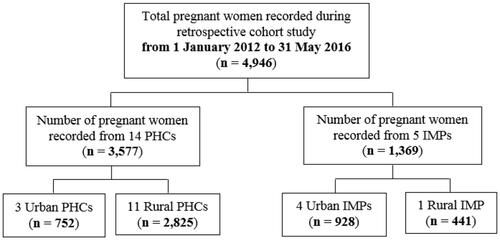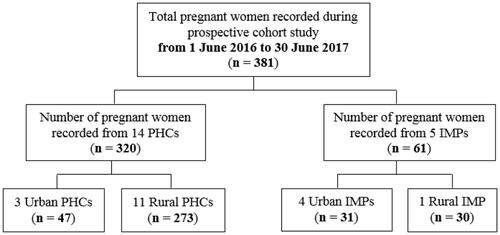Figures & data
Table 1 Summary of Research Instrument and Data Collection
Figure 1 Retrospective data for assessing training outcomes.
Notes: Adapted from Anggraini D, Abdollahian M, Marion K, et al. The impact of scientific and technical training on improving routine collection of antenatal care data for maternal and foetal risk assessment: a case study in the Province of South Kalimantan, Indonesia. J Pregnancy. 2018;2018. Copyright © 2018 Dewi Anggraini et al. This is an open access article distributed under the Creative Commons Attribution License, which permits unrestricted use, distribution, and reproduction in any medium, provided the original work is properly cited.Citation26

Figure 2 Prospective data for assessing training outcomes.
Notes: Adapted from Anggraini D, Abdollahian M, Marion K, et al. The impact of scientific and technical training on improving routine collection of antenatal care data for maternal and foetal risk assessment: a case study in the Province of South Kalimantan, Indonesia. J Pregnancy. 2018;2018. Copyright © 2018 Dewi Anggraini et al. This is an open access article distributed under the Creative Commons Attribution License, which permits unrestricted use, distribution, and reproduction in any medium, provided the original work is properly cited.Citation26

Table 2 Summary of Statistical Analysis
Table 3 Description of Midwives’ Characteristics (Number of Participating Midwives = 19)
Table 4 Baseline Characteristics and Antenatal Events (Retrospective Study, Number of Pregnant Women = 4946)
Table 5 Baseline Characteristics and Antenatal Events (Prospective Study, Number of Pregnant Women = 381)
Table 6 Data Recorded Before and After Training
Table 7 Fundal Height Assessment Recorded Before and After Training
Figure 3 FH and GA data available for fetal weight estimation. [Source: Anggraini, et al. Citation38]. (A) before training (retrospective data, n = 195). (B) after training (prospective data, n = 402).
![Figure 3 FH and GA data available for fetal weight estimation. [Source: Anggraini, et al. Citation38]. (A) before training (retrospective data, n = 195). (B) after training (prospective data, n = 402).](/cms/asset/2ec2ec39-8213-42fd-9e51-1d1dd2398a4d/djwh_a_12171254_f0003_c.jpg)
Figure 4 Fundal height growth assessment during critical periods of pregnancy. [Source: Anggraini, et al. Citation38]. (A) 13–42 weeks (n = 402). (B) 20–40 weeks (n = 402). (C) 20–35 weeks (n = 399). (D) 24–40 weeks (n = 401)
![Figure 4 Fundal height growth assessment during critical periods of pregnancy. [Source: Anggraini, et al. Citation38]. (A) 13–42 weeks (n = 402). (B) 20–40 weeks (n = 402). (C) 20–35 weeks (n = 399). (D) 24–40 weeks (n = 401)](/cms/asset/c9889e59-f4ea-43b8-96c7-59e2ce31cdcb/djwh_a_12171254_f0004_c.jpg)
Table 8 Factors and Reasons Influencing Midwives in Completing Routine Collection of ANC Data
